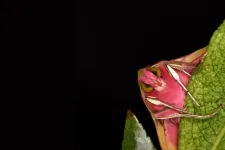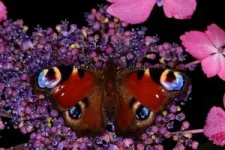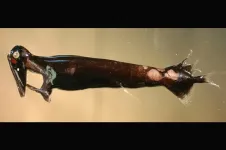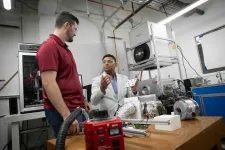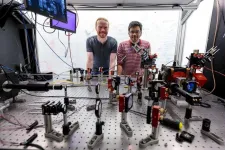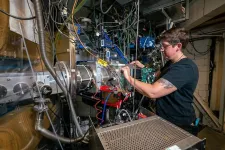(Press-News.org) Butterflies and moths collect so much static electricity whilst in flight, that pollen grains from flowers can be pulled by static electricity across air gaps of several millimetres or centimetres.
The finding, published today in the Journal of the Royal Society Interface, suggests that this likely increases their efficiency and effectiveness as pollinators.
The University of Bristol team also observed that the amount of static electricity carried by butterflies and moths varies between different species, and that these variations correlate with differences in their ecology, such as whether they visit flowers, are from a tropical environment, or fly during the day or night. This is the first evidence to suggest that the amount of static electricity an animal accumulates is a trait that can be adaptive, and thus evolution can act upon it by natural selection.
Lead author Dr Sam England from Bristol’s School of Biological Sciences, explained: “We already knew that many species of animal accumulate static electricity as they fly, most likely through friction with the air. There had also been suggestions that this static electricity might improve the ability of flower-visiting animals, like bees and hummingbirds, to pollinate, by attracting pollen using electrostatic attraction.
“However, it wasn’t known whether this idea applied to the wider array of equally important pollinators, such as butterflies and moths. So, we set out to test this idea, and see if butterflies and moths also accumulate charge, and if so, whether this charge is enough to attract pollen from flowers onto their bodies.”
Their study involved 269 butterflies and moths across 11 different species, native to five different continents and inhabiting multiple different ecological niches. They were then then able to compare between them and see if these ecological factors correlated with their charge, establishing if static charging is a trait that evolution can act upon.
Dr England added: “A clearer picture is developing of how the influence of static electricity in pollination may be very powerful and widespread.
“By establishing electrostatic charging as a trait upon which evolution can act, it opens up a great deal of questions about how and why natural selection might lead to animals benefiting or suffering from the amount of static electricity that they accumulate.”
In terms of practical applications, this study opens the door to the possibility for technologies to artificially increase the electrostatic charges or pollinators or pollen, in order to improve pollination rates in natural and agricultural settings.
Dr England concluded: “We’ve discovered that butterflies and moths accumulate so much static electricity when flying, that pollen is literally pulled through the air towards them as they approach a flower.
“This means that they don’t even need to touch flowers in order to pollinate them, making them very good at their jobs as pollinators, and highlighting just how important they might be to the functioning of our flowery ecosystems.
“For me personally, I would love to do a wider survey of as many different species of animal as possible, see how much static electricity they accumulate, and then look for any correlations with their ecology and lifestyle. Then we can really begin to understand how evolution and static electricity interact!”
Paper:
‘Electrostatic pollination by butterflies and moths’ by Sam J. England and Daniel Robert in Journal of the Royal Society Interface.
END
Butterflies accumulate enough static electricity to attract pollen without contact, new research finds
2024-07-24
ELSE PRESS RELEASES FROM THIS DATE:
Eyes for Love: Searching for light and a mate in the deep, dark sea, male dragonfishes grow larger eyes than the females they seek
2024-07-24
Chestnut Hill, Mass (07/24/2024) – A small but ferocious predator, the male dragonfish will apparently do anything for love. Or at least to find a mate.
A new study by researchers at Boston College found the eyes of the male dragonfish grow larger for mate-seeking purposes, making the dragonfish an anomaly in vertebrate evolution, the team reported today in the Royal Society journal Biology Letters.
Like many creatures that inhabit the dark depths of the sea, dragonfishes survive thanks to numerous ...
PNNL scientists tap nation’s fastest computers to explore critical science questions
2024-07-24
RICHLAND, Wash.—Researchers at the Department of Energy’s Pacific Northwest National Laboratory have been awarded more than 3 million node hours on the nation’s most powerful computers to explore questions around pathogens, climate and energy-efficient microelectronics.
Access to the nation’s supercomputers, granted to Margaret Cheung, Daniel Mejia Rodriguez and Po-Lun Ma, is a coveted prize among scientists. The node hours represent an investment of several million dollars in computing time awarded to PNNL scientists to explore important science questions.
The awards are among 44 projects awarded through ...
Peri-operative care of transgender and gender-diverse individuals: new guidance for clinicians and departments published
2024-07-24
New guidance on peri-operative care of transgender and gender-diverse individuals is today published in Anaesthesia (the journal of the Association of Anaesthetists) to guide best practice to ensure the safety and dignity of transgender and gender-diverse people in the peri-operative period. The guidance has been produced by a working group of experts including Dr Stuart Edwardson, Royal Infirmary of Edinburgh, Edinburgh, UK, and Dr Luke Flower, Victor Philip Dahdaleh Heart and Lung Research Institute, Cambridge, UK, and colleagues.
The number of people openly identifying ...
Clinical psychologist’s book addresses largely ignored problem: social anxiety
2024-07-23
RIVERISDE, Calif. -- We all have some social anxiety. The nervousness we might feel before giving a speech is one example. Some people, however, have more social anxiety than others, and limit their social engagement due to excessive chronic fears of being embarrassed or humiliated. Although such social anxiety is common in both adolescents and adults, it is rarely diagnosed and treated.
In a new book titled “Social Anxiety: Hidden Fears and Shame in Teens and Adults,” Thomas E. Brown, a clinical professor of psychiatry and neuroscience in the University of California, Riverside's School of Medicine , explains ...
Researchers leveraging AI to train (robotic) dogs to respond to their masters
2024-07-23
An international collaboration seeks to innovate the future of how a mechanical man’s best friend interacts with its owner, using a combination of AI and edge computing called edge intelligence.
The project is sponsored through a one-year seed grant from the Institute for Future Technologies (IFT), a partnership between New Jersey Institute of Technology (NJIT) and Ben-Gurion University of the Negev (BGU).
Assistant Professor Kasthuri Jayarajah in NJIT’s Ying Wu College of Computing is researching how to design a socially assistive model ...
Drawing water from dry air
2024-07-23
Earth’s atmosphere holds an ocean of water, enough liquid to fill Utah’s Great Salt Lake 800 times.
Extracting some of that moisture is seen as a potential way to provide clean drinking water to billions of people globally who face chronic shortages.
Existing technologies for atmospheric water harvesting (AWH) are saddled with numerous downsides associated with size, cost and efficiency. But new research from University of Utah engineering researchers has yielded insights that could improve efficiencies and bring the world one step closer to tapping the air as a culinary water source in arid places.
The study unveils the first-of-its-kind ...
Combining trapped atoms and photonics for new quantum devices
2024-07-23
Quantum information systems offer faster, more powerful computing methods than standard computers to help solve many of the world’s toughest problems. Yet fulfilling this ultimate promise will require bigger and more interconnected quantum computers than scientists have yet built. Scaling quantum systems up to larger sizes, and connecting multiple systems, has proved challenging.
Now, researchers at the University of Chicago’s Pritzker School of Molecular Engineering (PME) have discovered how to combine two powerful technologies—trapped atom arrays and photonic devices—to ...
A new way to make element 116 opens the door to heavier atoms
2024-07-23
Scientists at the Department of Energy’s Lawrence Berkeley National Laboratory (Berkeley Lab) are credited in the discovery of 16 of the 118 known elements. Now they’ve completed the crucial first step to potentially create yet another: element 120.
Today, an international team of researchers led by Berkeley Lab’s Heavy Element Group announced that they have made known superheavy element 116 using a titanium beam, a breakthrough that is a key stepping stone towards making element 120. The result was presented today at the Nuclear Structure 2024 conference; the science paper will be posted on the online repository ...
New genetic tool could identify drug targets for diseases associated with metabolic dysfunction
2024-07-23
There’s a glaring gap in our knowledge of cell metabolism: in many cases, we still don’t know exactly how nutrients are transported into the cell. Without that understanding, it’s extremely difficult, if not impossible, to develop treatments for the many diseases linked to the protein transporters that drive metabolism. Now, a new study in Nature Genetics presents a tool to map these metabolic gene functions more precisely. The platform, dubbed GeneMAP, has already identified one key gene-metabolite association at the heart of mitochondrial metabolism.
GeneMAP was developed in the laboratory of Kivanç Birsoy, ...
Plant Biologist Siobhan Brady named HHMI Investigator
2024-07-23
iobhan Brady, a professor in the Department of Plant Biology and Genome Center at the University of California, Davis, has been selected as a Howard Hughes Medical Institute (HHMI) Investigator. The prestigious Investigator program, which Brady describes as “life changing,” will provide her with roughly $9 million in research support over a seven-year term, with the option to renew.
Brady’s research aims to understand how plants use their roots to respond to environmental stressors, and to use this information to develop plants that are better able to respond to climate ...
